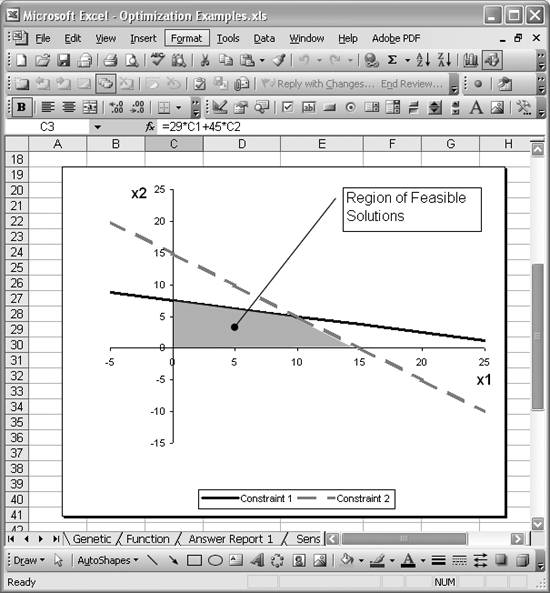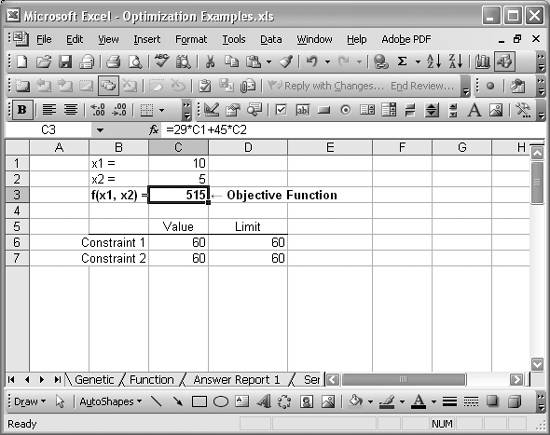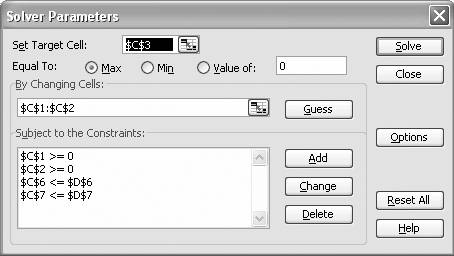Using Excel for Traditional Linear Programming
Problem
You've formulated an optimization problem in traditional linear programming form and would like to use Excel to solve the problem.
Solution
Use Solver's linear optimization capabilities.
Discussion
Linear optimization problems can be written in the form of an objective function to maximize (or minimize) subject to constraints. Constraints can be written in the form of inequalities or equalities. Consider this simple example:
Objective function

Constraints

If this were a product mix type of problem, the variables x1 and x2 could represent different products subject to some availability or production constraints, while the objective function could represent total profit given the mix of products produced. The idea is to find the optimum mix of products so as to maximize profit. Linear optimization is not limited to this sort of product mix problem. For example, your problem could consist of trying to maximize the vitamin content of a livestock feed given certain ingredients, subject to their availability and cost. Or your problem could consist of trying to minimize the cost of labor for producing certain products in your laboratory (see the next recipe for a hypothetical example).
Moreover, the problem need not be limited to two variables. You can have any number of variables and constraints, depending on your problem. I chose two variables for this simple example because we can plot it using Excel's charting feature and gain some insight into the solution. Problems with more variables are much more difficult, if not impossible, to visualize adequately. Such problems require you to exercise great care when searching for a solution (particularly if the problem is nonlinear) or to simplify the problem in ways that will allow you to visualize certain variables while holding others constant.
Getting back to our simple example, Figure 13-1 shows a graph of our problem. I used Excel's charting features (see Chapter 4) to prepare this graph.
This graph essentially consists of the constraints for the problem within the x1, x2 space. The two straight lines labeled Constraint 1 and Constraint 2 represent the first two constraints. The shaded region below these constraints represents the region of feasible values for x1 and x2 that are within the given constraints. Notice that this region is bounded by the x1- and x2-axes because we also have the two greater-than-or-equal-to-zero constraints on these variables.
Figure 13-1. Graph of linear optimization example

|
From this graph, you can deduce that the optimum solution corresponds to (x1,x2) = (10,5), which is at the intersection of the two constraint lines. You can use Solver to verify this result.
Figure 13-2 shows a simple spreadsheet I set up to facilitate finding optimum values for x1 and x2 so as to maximize the objective function.
Figure 13-2. Linear optimization example

Cell C3 contains the righthand side of the objective function. The formula is =29*C1+45*C2. The values for x1 and x2 shown in Figure 13-2 are indeed the optimum values, and the value of 515 for the objective function is the maximum value. Before calling Solver, cells C1 and C2 contain only initial guesses for the optimum. I had initially set these to 0.
Cells C6 and C7 contain formulas corresponding to Constraint 1 and Constraint 2, respectively. The formula in C6 is =2*C1+8*C2, and the formula in C7 is =4*C1+4*C2. These formulas represent the lefthand side of the constraint equations shown earlier. The limiting values (called righthand side values) for these constraints are contained in cells D6 and D7.
Figure 13-3 shows the Solver model I used to solve this problem.
The target cell is C3 and I instructed Solver to attempt to maximize its value. The cells to change are C1 and C2, corresponding to x1 and x2, respectively. There are four constraints as well. Refer to Recipe 9.4 to learn how to add constraints in Solver.
Figure 13-3. Solver model for linear optimization

The first two constraints shown in Figure 13-3 correspond to the constraints that x1 and x2 must be greater than or equal to 0. The last two constraints correspond to the constraint equations discussed earlier, that is, Constraint 1 and Constraint 2 as plotted in Figure 13-1.
I also set the Solver option Assume Linear Model for this problem, since it is a linear optimization problem. See the introduction to Chapter 9 for a discussion of Solver's options. Pressing the Solve button results in the optimum solution shown earlier in Figure 13-2.
See Also
As I mentioned in the introduction to Chapter 9, Solver can generate several reports for you upon finding a solution. See Recipe 13.6 for more information.
Using Excel
- Introduction
- Navigating the Interface
- Entering Data
- Setting Cell Data Types
- Selecting More Than a Single Cell
- Entering Formulas
- Exploring the R1C1 Cell Reference Style
- Referring to More Than a Single Cell
- Understanding Operator Precedence
- Using Exponents in Formulas
- Exploring Functions
- Formatting Your Spreadsheets
- Defining Custom Format Styles
- Leveraging Copy, Cut, Paste, and Paste Special
- Using Cell Names (Like Programming Variables)
- Validating Data
- Taking Advantage of Macros
- Adding Comments and Equation Notes
- Getting Help
Getting Acquainted with Visual Basic for Applications
- Introduction
- Navigating the VBA Editor
- Writing Functions and Subroutines
- Working with Data Types
- Defining Variables
- Defining Constants
- Using Arrays
- Commenting Code
- Spanning Long Statements over Multiple Lines
- Using Conditional Statements
- Using Loops
- Debugging VBA Code
- Exploring VBAs Built-in Functions
- Exploring Excel Objects
- Creating Your Own Objects in VBA
- VBA Help
Collecting and Cleaning Up Data
- Introduction
- Importing Data from Text Files
- Importing Data from Delimited Text Files
- Importing Data Using Drag-and-Drop
- Importing Data from Access Databases
- Importing Data from Web Pages
- Parsing Data
- Removing Weird Characters from Imported Text
- Converting Units
- Sorting Data
- Filtering Data
- Looking Up Values in Tables
- Retrieving Data from XML Files
Charting
- Introduction
- Creating Simple Charts
- Exploring Chart Styles
- Formatting Charts
- Customizing Chart Axes
- Setting Log or Semilog Scales
- Using Multiple Axes
- Changing the Type of an Existing Chart
- Combining Chart Types
- Building 3D Surface Plots
- Preparing Contour Plots
- Annotating Charts
- Saving Custom Chart Types
- Copying Charts to Word
- Recipe 4-14. Displaying Error Bars
Statistical Analysis
- Introduction
- Computing Summary Statistics
- Plotting Frequency Distributions
- Calculating Confidence Intervals
- Correlating Data
- Ranking and Percentiles
- Performing Statistical Tests
- Conducting ANOVA
- Generating Random Numbers
- Sampling Data
Time Series Analysis
- Introduction
- Plotting Time Series Data
- Adding Trendlines
- Computing Moving Averages
- Smoothing Data Using Weighted Averages
- Centering Data
- Detrending a Time Series
- Estimating Seasonal Indices
- Deseasonalization of a Time Series
- Forecasting
- Applying Discrete Fourier Transforms
Mathematical Functions
- Introduction
- Using Summation Functions
- Delving into Division
- Mastering Multiplication
- Exploring Exponential and Logarithmic Functions
- Using Trigonometry Functions
- Seeing Signs
- Getting to the Root of Things
- Rounding and Truncating Numbers
- Converting Between Number Systems
- Manipulating Matrices
- Building Support for Vectors
- Using Spreadsheet Functions in VBA Code
- Dealing with Complex Numbers
Curve Fitting and Regression
- Introduction
- Performing Linear Curve Fitting Using Excel Charts
- Constructing Your Own Linear Fit Using Spreadsheet Functions
- Using a Single Spreadsheet Function for Linear Curve Fitting
- Performing Multiple Linear Regression
- Generating Nonlinear Curve Fits Using Excel Charts
- Fitting Nonlinear Curves Using Solver
- Assessing Goodness of Fit
- Computing Confidence Intervals
Solving Equations
- Introduction
- Finding Roots Graphically
- Solving Nonlinear Equations Iteratively
- Automating Tedious Problems with VBA
- Solving Linear Systems
- Tackling Nonlinear Systems of Equations
- Using Classical Methods for Solving Equations
Numerical Integration and Differentiation
- Introduction
- Integrating a Definite Integral
- Implementing the Trapezoidal Rule in VBA
- Computing the Center of an Area Using Numerical Integration
- Calculating the Second Moment of an Area
- Dealing with Double Integrals
- Numerical Differentiation
Solving Ordinary Differential Equations
- Introduction
- Solving First-Order Initial Value Problems
- Applying the Runge-Kutta Method to Second-Order Initial Value Problems
- Tackling Coupled Equations
- Shooting Boundary Value Problems
Solving Partial Differential Equations
- Introduction
- Leveraging Excel to Directly Solve Finite Difference Equations
- Recruiting Solver to Iteratively Solve Finite Difference Equations
- Solving Initial Value Problems
- Using Excel to Help Solve Problems Formulated Using the Finite Element Method
Performing Optimization Analyses in Excel
- Introduction
- Using Excel for Traditional Linear Programming
- Exploring Resource Allocation Optimization Problems
- Getting More Realistic Results with Integer Constraints
- Tackling Troublesome Problems
- Optimizing Engineering Design Problems
- Understanding Solver Reports
- Programming a Genetic Algorithm for Optimization
Introduction to Financial Calculations
- Introduction
- Computing Present Value
- Calculating Future Value
- Figuring Out Required Rate of Return
- Doubling Your Money
- Determining Monthly Payments
- Considering Cash Flow Alternatives
- Achieving a Certain Future Value
- Assessing Net Present Worth
- Estimating Rate of Return
- Solving Inverse Problems
- Figuring a Break-Even Point
Index
EAN: 2147483647
Pages: 206

 Lines
Lines 